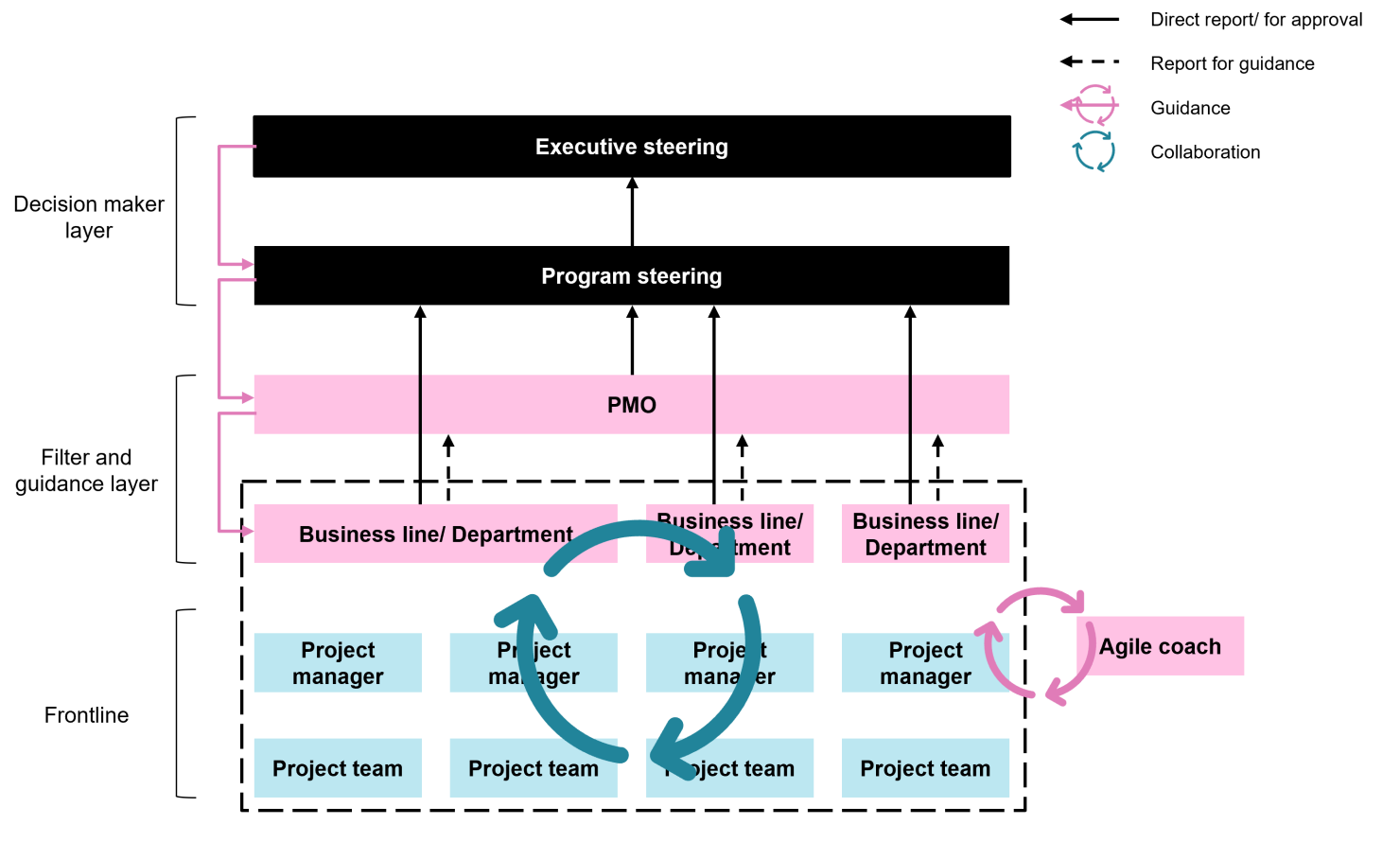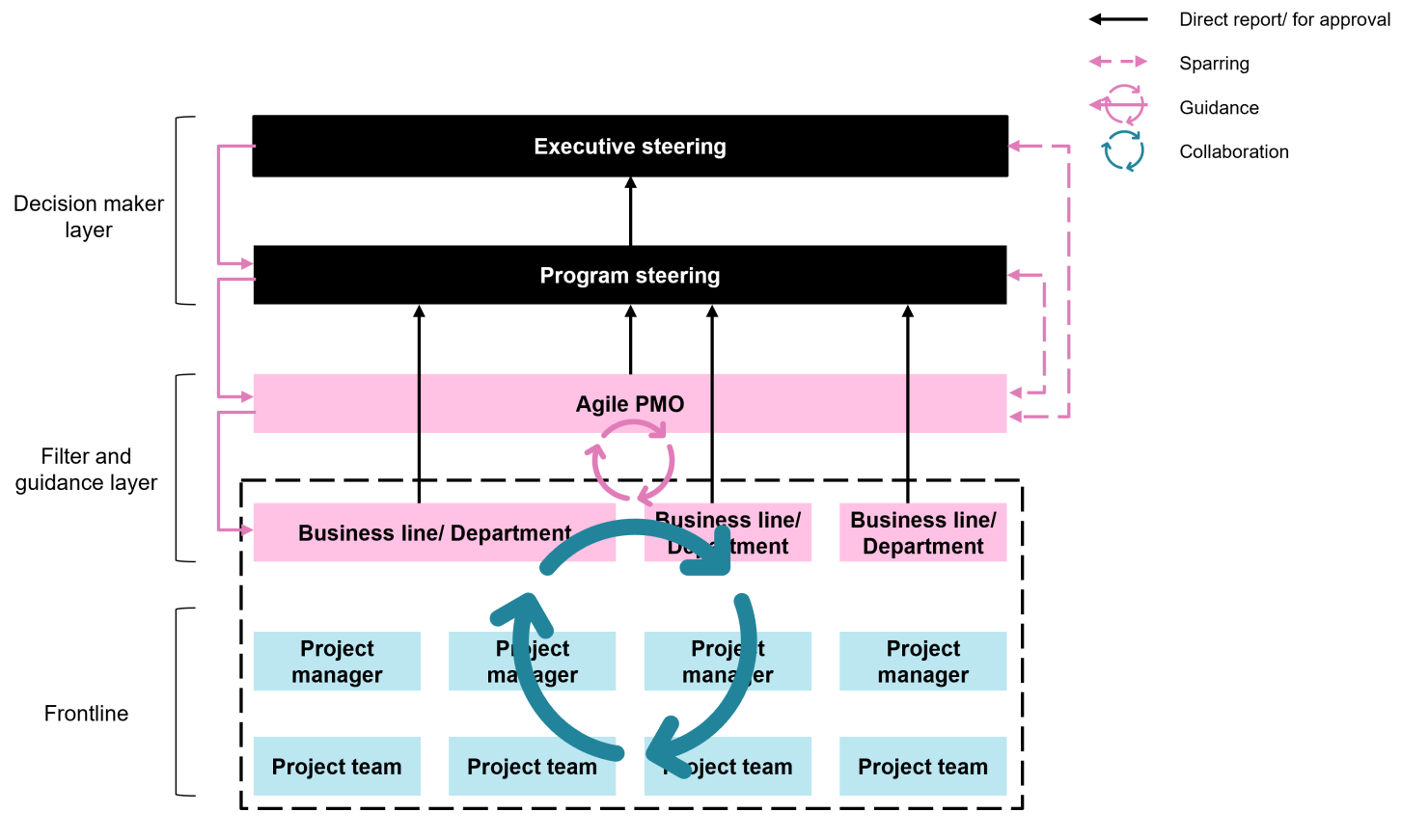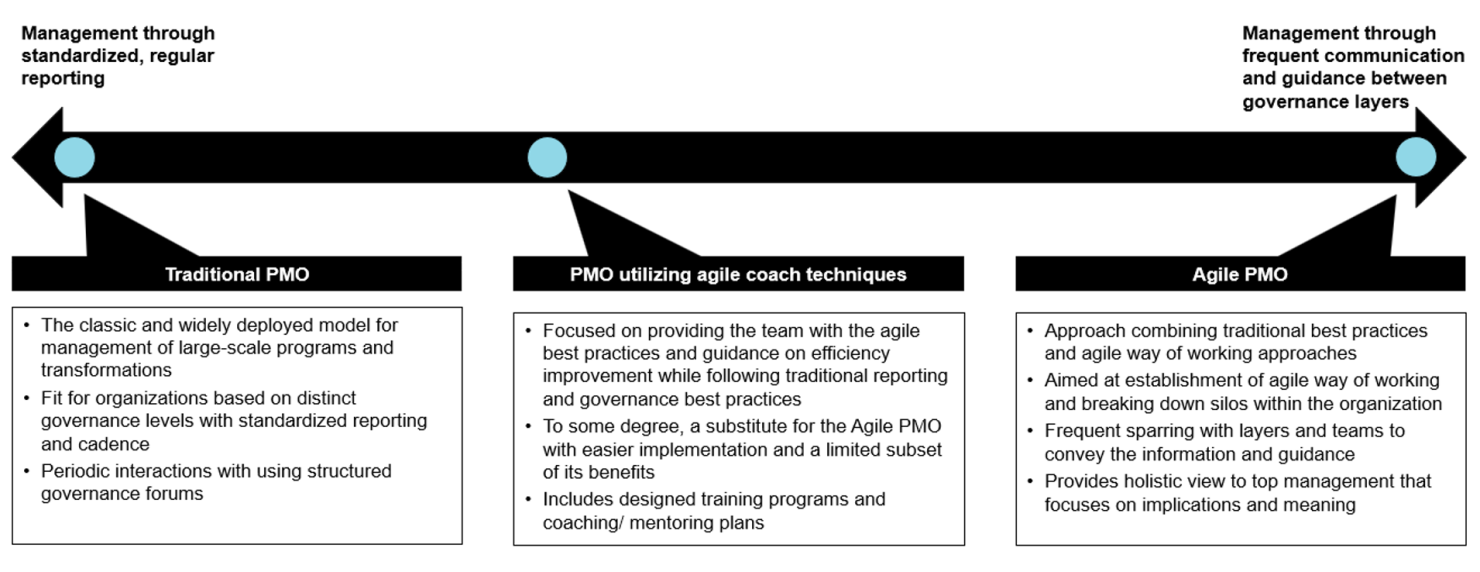Bringing agility to a traditional PMO to thrive in volatile situations
21 March 2024 — The program management office (PMO) has long been essential for large-scale programs and transformations. In this article, we provide a blueprint for integrating the latest best practices, with the advances in agile and lean methodologies, into a traditional PMO setup.

Problem
The traditional PMO structure provides standardized way of working but lacks agility in areas that require fast decision making for immediate impacts. Teams often work in silos for 1-4 weeks before reporting to the PMO. This practice easily leads to double work, slow progress, and localized solutions.
Why it happens?
Traditional PMO operates with several layers of decision-making forums with pre-defined agendas scheduled in regular, often infrequent intervals. Usually, these are the only times when frontline insights are shared across teams and guidance is provided.
Solution
Establishing an agile and proactive PMO in the organization that acts as a “spider in the web”, who can speed up information transfer between decision makers and frontlines, often through back channels. It can unlock the entire problem-solving capability of an organization by connecting the right, otherwise siloed, people, and proactively remove roadblocks to drive impact.
Download this post (PDF)
The concept of PMO or program management office has been around for decades and played an integral part in bringing large scale programs and transformations to fruition. For any change, improvement or larger transformation, solid follow-up and support is needed. Usually this is done using a program office. Generally, a program management office (PMO) is established whenever there is a need to manage large programs containing several projects. Those large programs can be related to post-merger integration, corporate restructurings or simply strategy implementation. No matter what the business situation is, the nature of a PMO and the way of working in it are relatively standard. The structure (figure 1) promotes an organization that is based on distinct governance levels with standardized reporting and cadence where information flow is periodic and usually happens between layers.

It is important to note that a PMO can be one person or a team of project managers belonging to the PMO office in the case of a large program. Usually, project managers are responsible for specific program streams and are led by the Head of PMO. In this article, we use the singular form, but the concepts described apply similarly to a team setting.
A company can gain a competitive edge by combining the benefits of traditional PMO practices and agile way of working into an agile PMO. Doing so not only improves frontline efficiency and speed of decision making but also helps management understand issues holistically.
Agile coach provides only partial benefits and agile PMO can unleash full potential
As traditional PMO operates with several layers of decision-making forums with pre-defined agendas that are scheduled at regular intervals. Insights from frontlines are usually already filtered through several layers before reaching the decision-making layer. This setup results in disconnection between the frontlines and decision makers and creates a reactive organization operating with incomplete information. Furthermore, as elements such as frequent interaction, constant information exchange and iteration among key stakeholders are introduced as a remedy to manage rapid changes, the whole process only becomes more complex and overburdened with reporting.
In response, organizations introduce an agile coach who can support the teams with agile best practices and provide guidance on how to be more efficient and break down silos among development teams (figure 2). An agile coach helps an organization adopt agile best practices while making agile values and mindset habitual. Dedicated training programs are available for anyone who seeks an agile coach certificate.

The traditional PMO and agile coach bring own benefits, but these approaches are fundamentally different and challenging to merge. The solution lies in creating a new role of agile PMO, which grows out of the organization and has considerable end-to-end technical understanding, project management experience, network within the organization, and is familiar with agile way of working.
On top of the traditional duties of PMO, the agile PMO proactively and continuously works with all project teams and function or department leadership as figure 3 shows. The goal is to not only establish agile way of working in the organization, but also break down silos by connecting solutions and members of different teams for achieving the most optimal end-to-end solution for the company as a whole. Furthermore, by frequently sparring with project teams, mid- and top management, the agile PMO has a unique view on both big picture strategy and in-depth solution development.
It is also important to define what an agile PMO is not. He or she is not administrative support, but rather an operational accelerator who proactively works with project management and steering to develop an excellent solution in the shortest time possible.

A driven agile PMO brings benefits to the organization in three main ways.
- Firstly, by connecting dots that frontlines would not recognize without an end-to-end view. Focusing only on a subset of an overarching plan can easily lead to individualistic solutions that result in inefficiencies on company-level. The agile PMO can see through these issues by overseeing the majority of all development areas, recommend a solution that is more optimal for the big picture, and help breaking down obstacles proactively by aligning with all key stakeholders.
- Secondly, by shortening product development timeline through thinner governance structure and pre-filtered steering materials. Especially in traditional industries, development teams frequently fall into the trap of developing products internally for too long without aligning with key decision makers. Long steering cycles can significantly delay development efforts if the product team’s vision does not align with that of the steering members. Agile PMO can cut down on development time by making sure that the top management’s vision is reflected in the proposed development through frequent sparring with the project team and project manager.
- Thirdly, by being a middleman between top management and project teams to serve as “keeper of holistic truth”. Providing guidance to the project teams on the big picture is valuable, but the opposite can benefit the organization as well. Top management can gain important insights from the agile PMO on overall development progress, major issues that can delay progress or team well-being and efficiencies. The agile PMO can be an excellent sparring partner on operational topics that can improve decision making.
Naturally, the agile PMO must have credibility and authority, whether formal or informal, for the project teams and department heads to follow his or her guidance even if they do not fully agree to it. This crucial detail ensures that real change happens in the organization and not fall victim to internal politics .
Transforming towards a fully agile way of working takes intermediate steps
Changing long-held habits is difficult and should be managed carefully, especially in slow moving industries. Implementing an agile PMO into the organization and significantly changing the way of working at once can cause high stress on the people. For many organizations, a step-by-step approach is more impactful. This involves starting with implementing agile best practices on smaller scale first by an agile coach, essentially building the foundation for a larger change. Once agile best practices are generally accepted, the transformation can move forward by implementing an agile PMO and revising governance subsequently. The key is evaluating the organization’s readiness for change and pacing the transformation accordingly. The three main steps can be observed in figure 4.

The key differences between the two approaches are the general way of working and mindset. Traditional PMO is highly hierarchical and operates through a well-defined governance process, meeting structure and reports. It periodically reviews progress, provides guidance and assess risks, but rarely interferes with the frontlines. As such, traditional PMO utilizes the “driver from the cockpit” type leadership, which is more retroactive in its nature.
On the other hand, the agile PMO acts as “spider in the web”. Well-defined governance structure and reporting are in place also, but the mindset changes to proactive daily cross-functional problem-solving facilitation, instead of seldom progress evaluation. The aim of the agile PMO is to actively support frontlines and ensure solution development that satisfies the leadership team’s vision without any rework.
It is imperative to find the right person for the role. Soft skills, such as verbal and written communication, relationship building and management with people from all levels of the organization are the most important characteristics. Moreover, for the agile PMO to be seen as a credible sparring partner across the organization, they must be knowledgeable with Project management best practices and agile methodology and tools. the PMO should demonstrate this proficiency in practice, aiding teams in their tasks and elevating the PMO's role to that of problem solver and sparring partner from the project's outset. Department heads and frontline employees must see the agile PMO as an aid who can effectively remove obstacles by negotiating cross-functional issues and deliver guidance and insights between the C-suite and frontlines. Additionally, underperforming departments benefit from active coaching, ultimately elevating the performance standards across the organization.
Commitment for change stemming from all layers of the organization is another key enabler towards an effective agile PMO. Executives must clearly recognize the agile PMO as the main program development driver. Concurrently, the existing governance structure, reporting routines, project and risk management processes must be revised to incorporate agile principles. These changes might be difficult for the organization at first, but a well-defined, yet dynamic structure of way of working, governed by one single point of contact makes solving issues across the organization convenient for stakeholders.
With the right person, commitment to change, and clear governance structure and processes, the organization is ready to implement agile PMO practices in its daily operations. For these practices to work, the agile PMO must be completely transparent in terms of intentions and information sharing. It is natural behavior for humans to reveal their success and hide their mistakes. Usually, small mistakes or bottlenecks would not be a significant issue at first, however, they can create a cascading snowball effect that will eventually overspill and negatively affect the organization in long term. Professional agile PMOs must reveal all the facts, successes, and mistakes across the organization and prewarn both executives and frontlines. Naturally, there is some push back in the beginning, but once the organization starts to see the benefits of transparency, for example, executives actively problem-solve to support the frontlines rather than discuss issues on high-level, it will gradually shift towards better visibility, trust, and action-oriented problem-solving.
In addition, just like agile teams, agile PMOs are focused on continuous improvement. They regularly review processes, practices, and outcomes to identify areas for improvement and implement changes to enhance agility and efficiency, while coaching the project teams through out the way, which will eventually build a culture of continuous improvement and encourage teams to reflect on their processes, share lessons learned, and implement changes to enhance efficiency and effectiveness within the organization.
Agile PMO brings significant benefits but require carefully designed implementation
Amid ever changing business environment, rethinking long-held ideas about program and project management is worth the effort even in the most traditional industries. An agile PMO can improve risk management processes, minimize project uncertainties, and increase project success rates. Frontlines can benefit from the agile PMO as an agile change agent and knowledgeable sparring partner with a big picture view, while management gains structured, truly insightful information for better decision-making.
In conclusion, efforts to bring agility to a traditional PMO require a carefully planned step-by-step approach. Implementing agile best practices on smaller scale first by an agile coach can be an interim step before introducing agile PMO to the entire organization. Having the right person, commitment to change, and clear governance structure and processes are key enablers to agile PMO practices in its daily operations. Furthermore, transparency and continuous improvement safeguard the sustainable benefits from agile PMO.
Tags
Program Management Office, Organizational transformation, Growth strategy, Corporate strategy, PMO













